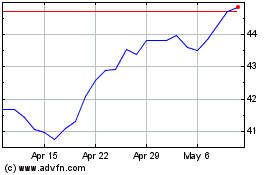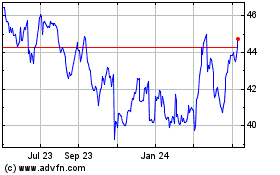By Theo Francis
After a tough end to 2015, big companies are starting the new
year with a tight rein on capital spending, and in some cases
layoffs, as they seek to cope with sluggish industrial demand and
uncertainties about the continued resilience of the American
consumer.
A half-dozen large companies from medical-products giant Johnson
& Johnson and tobacco maker Altria Group Inc. to Internet
portal Yahoo Inc. have announced plans to cut about 14,000 jobs in
recent weeks. Others, including railroad Norfolk Southern Corp. and
oil producer Chevron Corp., are pulling back on their spending
plans.
"We know this is a tough environment in which to talk about
growth," Norfolk Southern CEO James Squires recently told
investors. "That's why we are so focused on cost reductions."
The cautious approach suggests that executives remain wary as
the strong dollar and weak growth in developing markets hurts their
foreign sales, and the stock market's slide and fears of a downbeat
economy unsettle investors and consumers at home, despite
improvements in housing and employment.
American consumers--the bulwark of the economy--are sending
mixed signals: December brought disappointing government figures on
consumer spending and retail sales, but companies like Starbucks
Corp., Ford Motor Co. and Nike Inc. continue to log strong domestic
sales.
"The U.S. is basically relying on one sector to generate most of
the growth, which is consumer," said Joseph LaVorgna, chief U.S.
economist for Deutsche Bank Research. "When you don't have breadth,
you're vulnerable to a shock."
Overall, companies in the S&P 500 index are on track to
report adjusted fourth-quarter profits down 4.1% from a year
earlier, and sales down 3.5%, according to Thomson Reuters. That
would mark two consecutive quarters of shrinking earnings for the
first time since 2009, and four straight quarters of falling
sales.
Much of the overall decline reflects a battered energy sector,
which is expected to report a 75% drop in fourth-quarter earnings
and a 35% decline in sales, Thomson Reuters projects. Chevron, BP
PLC and ConocoPhillips all reported deep fourth-quarter losses.
Excluding energy companies, adjusted earnings for S&P 500
companies are expected to rise 2.1% on sales growth of just 0.9%.
Adjusted earnings, widely used by investment analysts, exclude
costs and gains considered unusual or ancillary to the company's
core operations.
Concerns about a slowdown in manufacturing aren't new. But
economic growth outside the manufacturing sector, as measured by
the Institute for Supply Management, slowed in January, settling to
the slowest pace in nearly two years, according to Oxford
Economics. And several sectors are expected to post lower profits,
including consumer staples and utilities, according to Thomson
Reuters. Earnings growth is expected to grind to a halt in the
technology sector.
For the most part, consumers have provided reliable support as
energy prices have slumped and growth has faltered in emerging
markets. In addition to companies like Starbucks and Nike, Royal
Caribbean Cruises Ltd. reported growing demand, after a brief
period of weakness following terrorist attacks in Paris last fall.
"We are seeing particular strength from the North American
consumer," Chief Financial Officer Jason Liberty said on an
earnings call last Tuesday.
And consumer-products companies cited signs that Americans are
more willing to pay a little more for new, brand-name or
higher-quality products. Procter & Gamble Co., which reported a
2% increase in organic sales, which exclude acquisitions, improved
from a 1% decline the previous quarter. It said competitors were
concentrating efforts on new, costlier products, rather than on
cutting prices to win business.
Few executives predict significant growth in the coming year,
and are responding by pulling back on business investment.
With nearly a third of S&P 500 companies reporting detailed
year-end financial results through early last week, capital
expenditures were up 6.2% from a year earlier, said Howard
Silverblatt, senior index analyst at S&P Dow Jones Indices.
That is less than half the 13.9% increase reported in the last
quarter of 2014, though much of the slowdown comes from energy
companies, Mr. Silverblatt said.
Industrial and manufacturing companies were most emphatic about
reining in spending, or at least holding the line. Norfolk Southern
reported lower coal shipments amid low energy prices, and said
retail inventories remained high, reducing shipping demand further.
Executives said the company reduced capital spending by $100
million last year "to adapt to the shifting economic environment,"
and executives said they are poised to reduce it further if
necessary.
Oshkosh Corp., a maker of heavy vehicles and equipment, said the
rental firms among its customers are taking a
more-cautious-than-expected approach to their own purchases of
construction vehicles and equipment in 2016, though sales of
emergency-services vehicles remain brisk.
"Many want to confirm that the construction market in the U.S.
gets off to a good start before fully committing to their desired
equipment-purchasing plans," Oshkosh CEO Wilson Jones said on a
Jan. 28 call with investors.
U.S. Steel Corp., meantime, said it would emphasize multiple
smaller projects. "They're projects that have much less risk to
implement and return benefits much faster," said Dan Lesnak, a U.S.
Steel investor-relations executive, on a Jan. 27 earnings call.
"This is not the environment to kick off big, big massive
projects."
Still, some companies are taking the opportunity to invest in
their businesses. Harley-Davidson Inc. plans to boost capital
spending by as much as about 6% over last year, in part by
increasing spending on new products by 35%. "The overall growth in
the company is going to be driven by new products," as well as
additional marketing and international expansion, the company's
finance chief, John Olin, said on a recent earnings call.
Employment, ultimately, could hold the key to corporate profits
in coming quarters. Again, many of the signs remain solid. The
economy added 262,000 jobs in December, more than economists
expected, but growth for the full year fell short of 2014's 15-year
record, and jobs increased by a less-than-expected 151,000 in
January.
January jobs reports can be skewed by weather and the timing of
holidays, said Mr. LaVorgna, the Deutsche Bank economist. Still,
given corporate caution and existing trends in both the
manufacturing and nonmanufacturing sectors, Mr. LaVorgna said,
"there's some real concern that we're actually going to slow
further."
(END) Dow Jones Newswires
February 07, 2016 19:43 ET (00:43 GMT)
Copyright (c) 2016 Dow Jones & Company, Inc.
Altria (NYSE:MO)
Historical Stock Chart
From Mar 2024 to Apr 2024

Altria (NYSE:MO)
Historical Stock Chart
From Apr 2023 to Apr 2024
